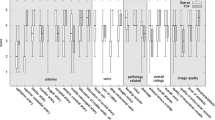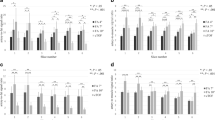Abstract
Thirty-eight patients with convexity lesions were studied prospectively with the two-dimensional time-of-flight (2D-TOF) magnetic resonance angiography (MRA) method. Of these 21 cases had additional surface anatomy scanning (SAS) and 7 cases had three-dimensional phase contrast (3D-PC) MRA. The findings were compared during surgery, and the predictability of 2D-TOF evaluated. 2D-TOF was obtained with 2 mm slice thickness after the administration of contrast media for routine magnetic resonance imaging (MRI). Cortical veins were visualized with a good resolution with a scan time of only 5 minutes. The tumor was also visible in the background, due to enhancement, and thus the tumor-vessels relation was shown. Slow-flow vessels were also adequately seen. SAS was done at the same sitting with fast spin echo (FSE) with a scan time of 3 minutes. Once both images were incorporated, information on gyri and their relation to the lesions and vasculature could be obtained from a single image. We found 2D-TOF alone, or at times in combination with SAS, useful for planning of operation for convexity lesions.
Similar content being viewed by others
References
Axel L: Blood flow effects in magnetic resonance imaging. AJR 143 (1984) 1157–1166
Bosmans H, G Marchal, G Lukito, N Yicheng, G Wilms, G Laub, AL Baert Time-of-flight MR angiography of the brain: comparison of acquisition techniques in healthy volunteers. AJR 164 (1995) 161–167
Bradley WG, V Waluch, KS Lai, EJ Fernandez, C Spalter: The appearance of rapidly flowing blood on magnetic resonance images. AJR 143 (1984) 1157–1174
Dumoulin CL, HR Hart Magnetic resonance angiography. Radiology 161 (1986) 717–720
Dumoulin CL, SP Souza, MIT Walker, W Wagle: Three-dimensional phase contrast angiography. Magn Reson Med 9 (1989) 139–149
Edelman RR, KU Wentz, H Mattee, B Zhao, C Liu, D Kim, G Laub: Projection arteriography and venography: Initial clinical results with MR. Card Radiology 172 (1989) 351–357
Edelman RR, D Chien, DJ Atkinson, J Sandstorm: Fast time-of-flight MR angiography with improved background suppression. Radiology 179 (1991) 867–870
Huston J, DA Rufenacht, RL Ehman, DO Wiebers: Intracranial aneurysms and vascular malformations: comparison of time-of-flight and phase-contrast MR angiography. Radiology 181 (1991) 721–730
Huston J, RL Ehman: Comparison of time-of-flight and phasecontrast MR neuroangiographic techniques. Radiographics 3 (1993) 5–19
Katada K: MR imaging of brain surface structures: Surface anatomy Scanning (SAS). Neuroradiology 32 (1990) 439–448
Keller PJ, BP Drayer, EK Fram, KD Williams, CL Dumoulin, SP Souza: MR angiography with two-dimensional acquisition and three-dimensional display. Radiology 173 (1989) 527–532
Lewin JS, G Laub: Intracranial MR angiography: A direct comparison of three time-of-flight techniques. AJNR 12 (1991) 1133–1139
Mattle HP, KU Wentz, RR Edelman, B Wallner, JP Finn, P Barner, DJ Atkinson, J Kleefield, HM Hoogewoud: Cerebral venography with MR. Radiology 178 (1991) 453–458
Rosen BR: Projective imaging of pulsatile flow with magnetic resonance. Science 230 (1985) 946–948
Ruggier PM, AL Gerhard, TJ Masaryk, MT Modic: Intracranialcirculation: pulse-sequence considerations in three-dimensional (volume) MR angiography. Radiology 171 (1989) 785–791
Smith KW: Time-of-flight methods in MR angiography. Radiol Technol 65 (1994) 159–170
Sumida M, T Uozumi, K Kiya, K Arita, K Kurisu, J Onda, H Satoh, F Ikawa, O Yukawa, K Migita, H Hada, K Katada: Surface anatomy scanning (SAS) in intracranial tumors: comparison with Surgical findings. Neuroradiology 37 (1995) 94–98
Author information
Authors and Affiliations
Rights and permissions
About this article
Cite this article
Pant, B., Sumida, M., Kurisu, K. et al. Usefulness of two-dimensional time-of-flight MR angiography combined with surface anatomy scanning for convexity lesions. Neurosurg. Rev. 20, 108–113 (1997). https://doi.org/10.1007/BF01138193
Received:
Accepted:
Issue Date:
DOI: https://doi.org/10.1007/BF01138193




